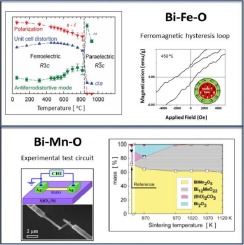当前位置:
X-MOL 学术
›
Prog. Cryst. Growth Ch. Mater.
›
论文详情
Our official English website, www.x-mol.net, welcomes your feedback! (Note: you will need to create a separate account there.)
Synthesis and characterization of electrical features of bismuth manganite and bismuth ferrite: effects of doping in cationic and anionic sublattice: Materials for applications
Progress in Crystal Growth and Characterization of Materials ( IF 5.1 ) Pub Date : 2018-02-01 , DOI: 10.1016/j.pcrysgrow.2018.02.001 A. Molak , D.K. Mahato , A.Z. Szeremeta
Progress in Crystal Growth and Characterization of Materials ( IF 5.1 ) Pub Date : 2018-02-01 , DOI: 10.1016/j.pcrysgrow.2018.02.001 A. Molak , D.K. Mahato , A.Z. Szeremeta

|
Abstract The electrical, magnetic, and structural features of bismuth manganite (BM), e.g., BiMnO3, and bismuth ferrite (BF), e.g., BiFeO3, are reviewed. Induced multiferroicity and enhanced magnetoelectric coupling are required for various modern device applications. BM and BF were synthesized using standard high-temperature sintering and processes such as sol–gel, hydrothermal, or wet chemical methods combined with annealing. The size and morphology of the nanoscale particles were controlled, although they were usually inhomogeneous. BF exhibits structurally stable antiferromagnetic (AFM) and ferroelectric (FE) phases in wide temperature ranges. Ferromagnetic (FM) order was induced in a thick shell around the AFM core of the nanoscale BF particles, which was attributed to a size effect related to surface strains and disorder. BM exhibited both structurally stable and unstable phases. The BiMnO3, Bi12MnO20, and BiMn2O5 structures are nonferroelectric. The perovskite BiMnO3 form was synthesized under high hydrostatic pressure. FM order occurs in BM at low temperatures. Bi(MnFe)O3 solid solution samples exhibited competition between AFM and FM ordering. Doping can decrease the content of unavoidable secondary phases. Doping in the Bi ion sublattice can stabilize the crystal lattice owing to local strains caused by the difference in ionic radius between Bi and the dopant. Doping in the Fe and Mn sublattices affects the electrical features. The main achievement of substitution with tetra- and pentavalent ions is compensation of the oxygen vacancies. In turn, leakage current suppression enables switching of FE domains and polarization of the samples. A significant enhancement of magnetoelectric coupling was observed in composites formed from BF and other FE materials. The leakage currents can be diminished when an insulator polymer matrix blocks percolation. The potential applicability is related to enhanced magnetoelectric coupling. The constructed devices meet the size effect limitations for FE and FM ordering. Resistive switching suggests possible use in nonvolatile memories and gaseous sensors. The sensors can be used for hydrophones and for photovoltaic and photoluminescence applications, and they can be constructed from multiphase materials. Bulk multiferroic solid solutions, composites, and nanoheterostructures have already been tested for use in sensors, transducers, and read/write devices for technical purposes.
中文翻译:

锰酸铋和铁氧体铋的电学特性的合成和表征:在阳离子和阴离子亚晶格中掺杂的影响:应用材料
摘要 综述了锰酸铋(BM)(例如BiMnO3)和铁氧体铋(BF)(例如BiFeO3)的电学、磁学和结构特征。各种现代设备应用需要诱导多铁性和增强的磁电耦合。BM 和 BF 是使用标准高温烧结和工艺合成的,如溶胶-凝胶、水热或湿化学方法结合退火。纳米级颗粒的尺寸和形态受到控制,尽管它们通常是不均匀的。BF 在较宽的温度范围内表现出结构稳定的反铁磁 (AFM) 和铁电 (FE) 相。在纳米级 BF 颗粒的 AFM 核周围的厚壳中诱导铁磁 (FM) 有序,这归因于与表面应变和无序相关的尺寸效应。BM 表现出结构稳定和不稳定的阶段。BiMnO3、Bi12MnO20 和 BiMn2O5 结构是非铁电体。钙钛矿 BiMnO3 形式是在高静水压力下合成的。FM 阶次出现在低温下的 BM 中。Bi(MnFe)O3 固溶体样品表现出 AFM 和 FM 排序之间的竞争。掺杂可以减少不可避免的第二相的含量。由于 Bi 和掺杂剂之间的离子半径差异引起的局部应变,在 Bi 离子亚晶格中掺杂可以稳定晶格。在 Fe 和 Mn 亚晶格中掺杂会影响电特性。用四价和五价离子取代的主要成就是氧空位的补偿。反过来,泄漏电流抑制能够切换 FE 域和样品的极化。在由 BF 和其他 FE 材料形成的复合材料中观察到磁电耦合的显着增强。当绝缘体聚合物基质阻止渗透时,可以减少泄漏电流。潜在的适用性与增强的磁电耦合有关。构建的设备满足 FE 和 FM 排序的尺寸效应限制。电阻开关表明可能用于非易失性存储器和气体传感器。这些传感器可用于水听器以及光伏和光致发光应用,它们可以由多相材料制成。块状多铁性固溶体、复合材料和纳米异质结构已经过测试,可用于传感器、换能器和读/写设备以用于技术目的。
更新日期:2018-02-01
中文翻译:

锰酸铋和铁氧体铋的电学特性的合成和表征:在阳离子和阴离子亚晶格中掺杂的影响:应用材料
摘要 综述了锰酸铋(BM)(例如BiMnO3)和铁氧体铋(BF)(例如BiFeO3)的电学、磁学和结构特征。各种现代设备应用需要诱导多铁性和增强的磁电耦合。BM 和 BF 是使用标准高温烧结和工艺合成的,如溶胶-凝胶、水热或湿化学方法结合退火。纳米级颗粒的尺寸和形态受到控制,尽管它们通常是不均匀的。BF 在较宽的温度范围内表现出结构稳定的反铁磁 (AFM) 和铁电 (FE) 相。在纳米级 BF 颗粒的 AFM 核周围的厚壳中诱导铁磁 (FM) 有序,这归因于与表面应变和无序相关的尺寸效应。BM 表现出结构稳定和不稳定的阶段。BiMnO3、Bi12MnO20 和 BiMn2O5 结构是非铁电体。钙钛矿 BiMnO3 形式是在高静水压力下合成的。FM 阶次出现在低温下的 BM 中。Bi(MnFe)O3 固溶体样品表现出 AFM 和 FM 排序之间的竞争。掺杂可以减少不可避免的第二相的含量。由于 Bi 和掺杂剂之间的离子半径差异引起的局部应变,在 Bi 离子亚晶格中掺杂可以稳定晶格。在 Fe 和 Mn 亚晶格中掺杂会影响电特性。用四价和五价离子取代的主要成就是氧空位的补偿。反过来,泄漏电流抑制能够切换 FE 域和样品的极化。在由 BF 和其他 FE 材料形成的复合材料中观察到磁电耦合的显着增强。当绝缘体聚合物基质阻止渗透时,可以减少泄漏电流。潜在的适用性与增强的磁电耦合有关。构建的设备满足 FE 和 FM 排序的尺寸效应限制。电阻开关表明可能用于非易失性存储器和气体传感器。这些传感器可用于水听器以及光伏和光致发光应用,它们可以由多相材料制成。块状多铁性固溶体、复合材料和纳米异质结构已经过测试,可用于传感器、换能器和读/写设备以用于技术目的。



























 京公网安备 11010802027423号
京公网安备 11010802027423号